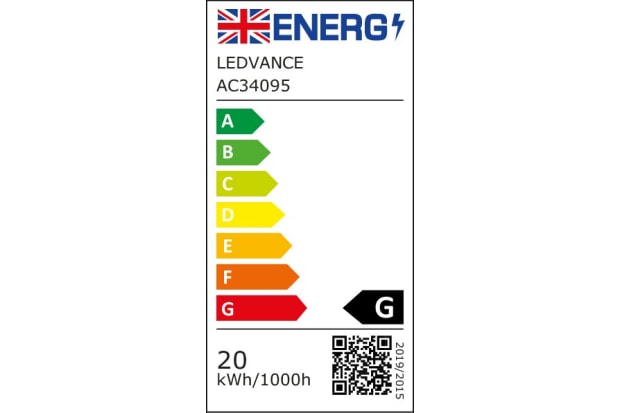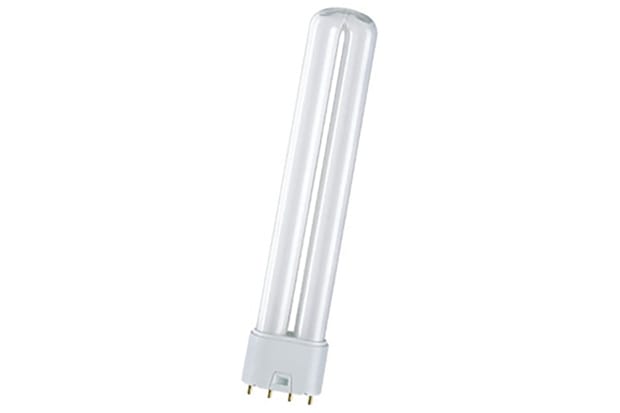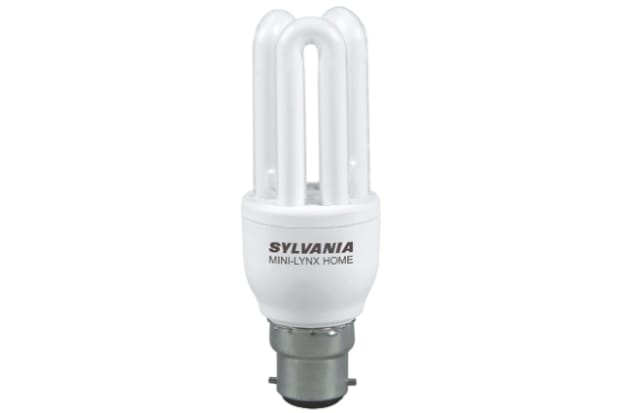- Published 17 Feb 2023
- Last Modified 6 May 2024
- 15 min
Fluorescent Tube Buying Guide
Discover more about the world of fluorescent tubes with our comprehensive buying guide. Explore the top brands, learn about the different types and sizes available, and make an informed decision for your lighting needs.

What is a Fluorescent Tube?
The fluorescent tube, also referred to as the fluorescent strip or tube light, is a low-pressure mercury vapour gas-discharge tube that converts fluorescence into visible light. This process involves the triggering of mercury vapour via an electric charge, resulting in the appearance of a short-wave ultraviolet light. This then causes the phosphor coating inside the tube to glow.
Fluorescent tubes have the advantage of benefitting from much greater energy efficiency than incandescent lamps. They are a relatively inexpensive form of lighting and have a relatively long life (although not as long as LEDs). Fluorescent tubes are used for a wide range of domestic and commercial applications.
Additional reasons for the use of fluorescent tubes include:
- High levels of light distribution and even diffusion
- Relatively low running costs
- Production of various colours, including white, red, and blue
Advantages of Using Fluorescent Tubes
Fluorescent tubes offer several advantages that make them a preferred choice for lighting in various settings:
- Their energy efficiency is significantly higher compared to traditional incandescent bulbs, reducing overall energy costs.
- They have a longer lifespan, which minimises the need for frequent replacements.
- Fluorescent tubes distribute light more evenly across spaces, providing uniform lighting that covers larger areas effectively.
- They are available in a range of colour temperatures, allowing for flexibility in creating desired atmospheres or meeting specific lighting requirements.
- Their low heat emission makes them safer for prolonged use, especially in confined or sensitive environments.
Fluorescent Tube Light vs LED
In the comparison of fluorescent tube light vs LED, several key differences should be noted regarding their differing energy efficiency, lifespan, environmental impact and cost-effectiveness. Fluorescent tubes operate by exciting mercury vapour, which in turn emits ultraviolet light that causes a phosphor coating inside the tube to glow. On the other hand, LEDs use semiconductor materials to convert electricity directly into light through the movement of electrons, making them more energy-efficient and environmentally friendly due to the absence of mercury.
Different Types of Fluorescent Tubes
Different types of fluorescent tubes vary in terms of shape, power, rating, length, colour, and other illuminating characteristics. It’s important to choose the right fluorescent tube by considering the design of your interior space and the lighting purposes.
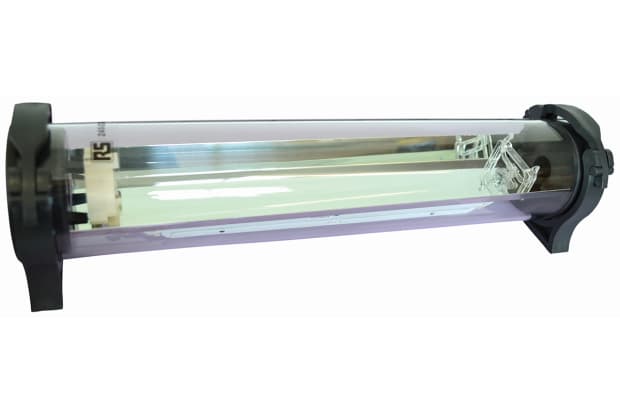
T4 Fluorescent Tubes
T4 fluorescent tubes have a slim design, making them easy to install. They are commonly used for kitchen displays and work-surface lighting. With a cool white colour and high energy efficiency, T4 tubes are a cost-effective option with an expected lifespan of around 10,000 hours.
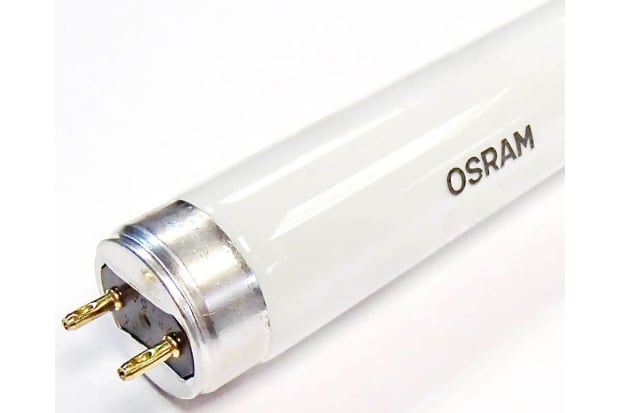
T5 Fluorescent Tubes
T5 fluorescent tubes are suitable for lighting offices, schools, and supermarkets. They offer cost savings and have an expected lifespan of up to 30,000 hours. T5 tubes feature an eco-friendly coating that prevents mercury absorption. Longer T5 tubes were introduced in Europe, based on multiples of the 300mm 'metric foot'. They have ballasting features for instant, rapid, and programmed start.
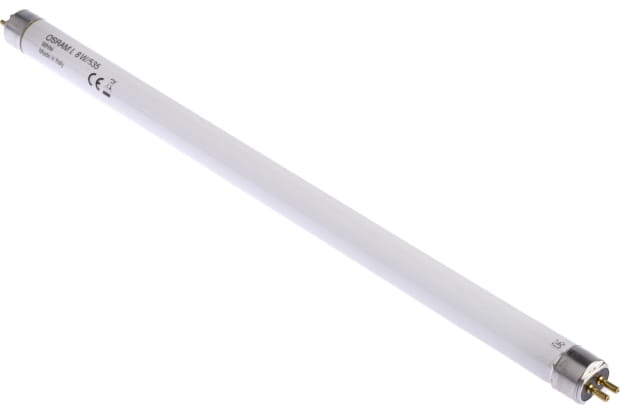
T8 Fluorescent Tubes
T8 fluorescent tubes are commonly used for domestic and commercial purposes due to their high light emission and colour rendering capabilities. They are energy-efficient and have been effective in treating seasonal affective disorder (SAD).
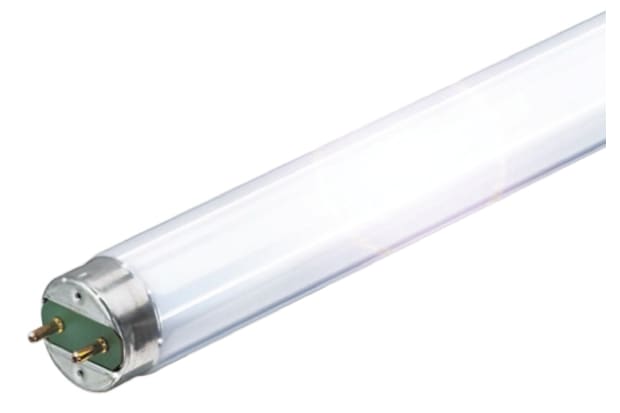
T12 Fluorescent Tubes
T12 fluorescent tubes are no longer produced since 2012. Retrofitting T12 fixtures is recommended by the EPA to reduce mercury and fossil fuel usage. T8 LEDs are a popular replacement option due to their comparable light generation and energy reduction.
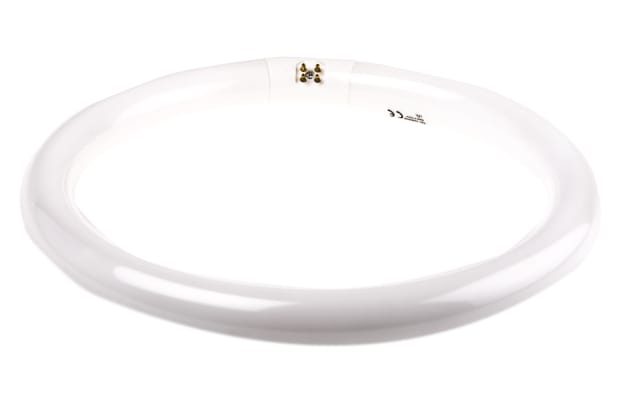
Circular Fluorescent Tubes
Circular fluorescent tubes, available in T5, T6, and T9 formats, are commonly used for well-lit interior spaces. They are energy-efficient and have a slimline design, ideal for ceiling lighting. Circular lamps are compatible only with existing circular fluorescent tube fixtures.
What Can Fluorescent Tubes Be Used for?
Fluorescent tubes and lamps are available in a variety of shapes and sizes. The compact fluorescent lamp has gained considerable popularity in recent times, and it is widely adopted in Hong Kong, as evidenced by the Hong Kong Government’s various waste reduction and recycling programmes for the tubes. It is quite common for the auxiliary electronics to be integrated within the base of the lamp, allowing for compatibility with the common light bulb socket.
Fluorescent tubing may be installed for lighting the following places:
- Residential rooms
- Storage areas
- Commercial office spaces
- Parking garages
- Retail stores
How to Choose the Right Fluorescent Tube
The installation of fluorescent tubing may result in significant financial savings for two main reasons - low running costs and a lengthy lifespan. These lights will also provide greater levels of illumination than standard incandescent light bulbs. As previously mentioned, fluorescent tubing is suitable for a wide variety of domestic and commercial applications. The tube diameter, length, and colour rendering should all have a bearing on the buying decision.
Fluorescent tubing can provide the following colour variations:
- Warm white
- White
- Cool white
- Natural
- Daylight
This table highlights the wide selection of fluorescent tubing available from RS Components:
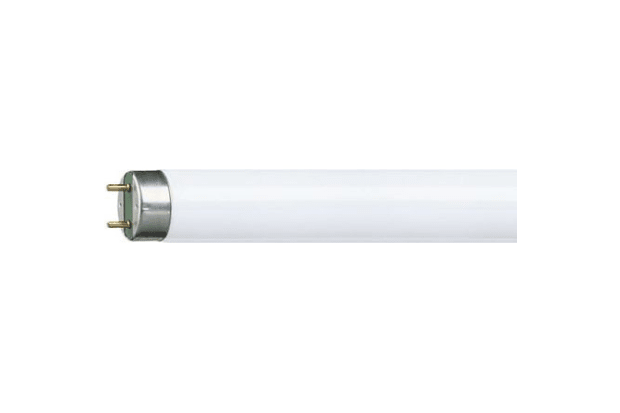
Philips Lighting Fluorescent Tubes
Main Benefits :
- Extended life expectancy of up to 20,000 hours
- Shatter-resistant versions available
Suitable Applications :
- Schools, offices, shops, and factories
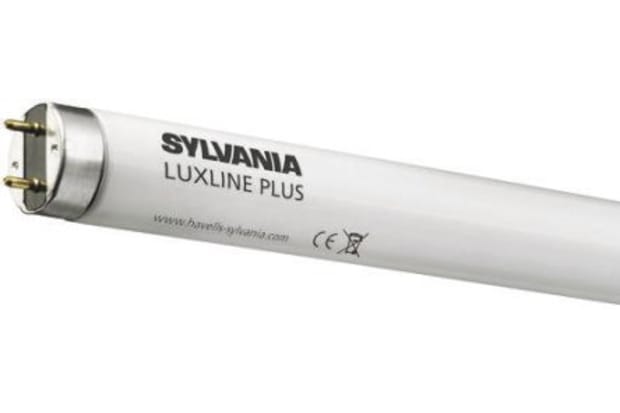
Sylvania Fluorescent Tubes
Main Benefits :
- Energy-efficient range
- Improved colour rendering performance
Suitable Applications :
- Suitable for a wide range of applications

Osram Fluorescent Tubes
Main Benefits :
- Advantages of a well-known brand
- Products available worldwide
Suitable Applications :
- Both domestic and commercial lighting
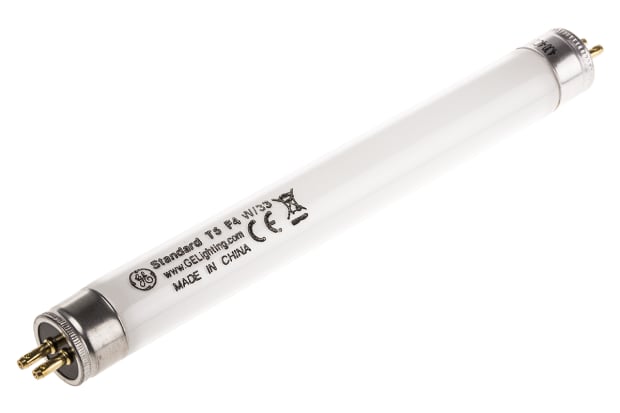
GE Fluorescent Tubes
Main Benefits :
- Excellent colour quality
- Longer lifespan and lower mercury outputs
Suitable Applications :
- Domestic use, signage, industrial applications
Fluorescent Tube Choices by Wattage
The number of watts will be indicated after the F on the fluorescent tube. As an example, an F8 tube with 24 watts will have the number F24T8. The level of light output will also have a bearing on the wattage of the fluorescent tube. The efficacy of the fluorescent tube will range from around 16 lumens per watt for a 4-watt tube with a regular ballast to more than 100 lumens per watt for a tube featuring a modern electronic ballast. The level of light emitted from the fluorescent tube is also affected by the lamp temperature in the coldest area of the lamp.
Fluorescent Tube Choices by Size
Fluorescent tubes are measured in eighths of an inch, with the measurement being drawn from pin to pin at the end of the tube. The wattage level is dependent on the length of the fluorescent tube. The sizes of fluorescent tubing range from T2 to T17. Production of the largest size T12 (38mm) has ceased. However, they featured the same G13 cap as the T8 tube. This means that it is possible to replace the T12 tube with a more efficient T8 of the same length.
The comparative sizes of fluorescent tubes are highlighted in this table:
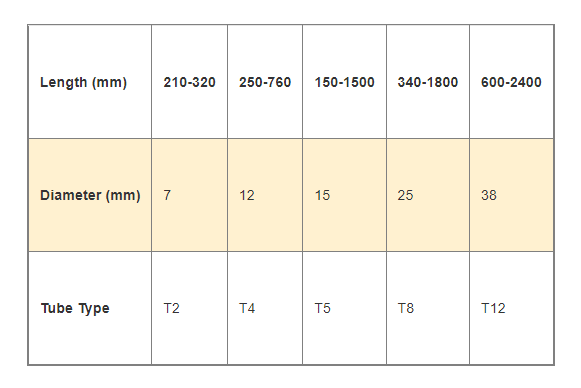
Popular Fluorescent Tube Brands
RS PRO
RS PRO offers a wide range of fluorescent tubes in various sizes and types. Our products are designed to deliver efficient and reliable lighting solutions for different applications in the field of fluorescent tubes.
Osram
Osram, a well-established brand in the lighting industry, has a rich history of producing innovative fluorescent tube solutions. With origins rooted in pioneering technology, Osram offers a diverse selection of high-quality fluorescent tubes. Their products are renowned for their durability and energy efficiency.
Philips Lighting
Philips Lighting is a leading brand synonymous with cutting-edge lighting solutions, including an extensive range of fluorescent tube products. With a legacy of innovation, Philips Lighting provides top-notch fluorescent tubes known for their superior performance and longevity.
Compare Fluorescent Tubes
There is such a wide selection of fluorescent tubing available that it may be a challenge to identify the type best suited to your needs. However, factors such as the type of socket, diameter, wattage, length, colour coding, and ballasting should all have a bearing on your buying decision, as should the following:
Type of Fluorescent Tube
As previously mentioned, fluorescent tubes range from the modern T2 to the old style T12. The slim-line T2 tubes feature a W4.3 fitting and a 4.3 mm wide push fitting. T4 tubes are best suited to under-cabinet lighting and have a G5 fitting with 5mm separating the two pins. Standard T8 tubes have a G13 fitting, with 13mm separating the pins. The T12 tubes came complete with the same G13 cap as the T8 tube, meaning that older T12 tubes can be replaced with T8 tubes.
Wattage of Fluorescent Tube
You should be aware that lumens are specific to the total amount of light emitted by the light source, while watts refer to the amount of energy consumed. As the levels of energy efficiency increase, the wattage decreases in relation to the generation of lumens.
The following table indicates the number of lumens that are generated at different wattages:
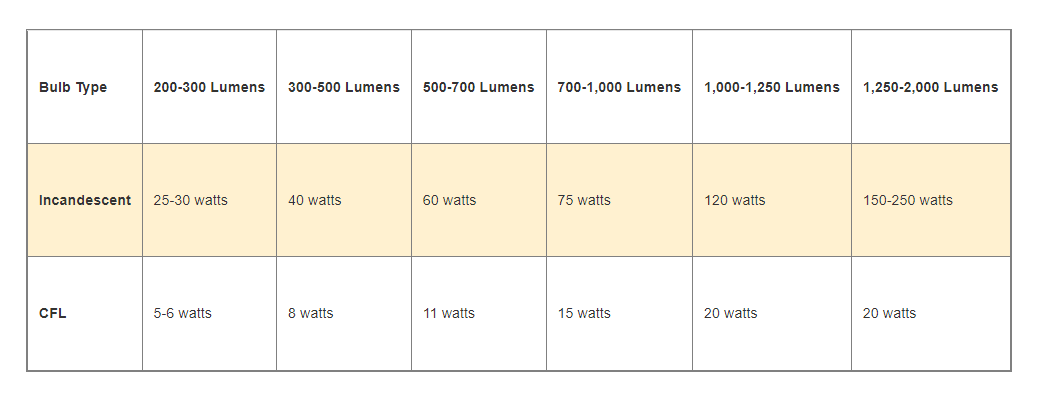
Length of Fluorescent Tube
As previously stated, you can establish the length of a fluorescent tube by measuring the total distance between the two end pins. The wattage commonly indicates the lengths of these tubes. The smallest fluorescent tube is the T2, and it has a length of between 250mm and 760mm. The next longest tube is the T4, with a total length of anywhere between 150mm and 1,500mm. This is followed by the T5, which has a length of between 340mm and 1,800mm. The length of the T8 tube may be anywhere from 600mm up to 2,400mm.
How to Fit a Fluorescent Tube Safely
Considerable care should be taken during the fitting of a fluorescent tube. Begin by turning off the power connected to the fitting. Any contact with the fitting and earthed elements should be avoided. It will be necessary to begin with the removal of the casing, which can then be placed in a safe and secure area. The tube should be gently twisted 90 degrees to release it from the light fitting. The attachment of the new fluorescent tube should begin with the placement of the short metal prongs in the corresponding holes. The new bulb should then be twisted gently through 90 degrees.
Maintenance Steps to Prolong the lifespan of the Fluorescent Tubes
To ensure fluorescent tubes maintain their efficiency and longevity, regular maintenance is essential:
- Start by cleaning the tubes and fixtures periodically to prevent dust accumulation, which can impact light output and efficiency. Use a soft cloth to wipe the tubes gently, avoiding harsh cleaning agents that may damage the phosphor coating.
- Check the electrical connections and fixtures for signs of wear or damage, as poor connections can reduce the lifespan of the tubes. Replace starters and ballasts as needed since faulty components can cause flickering or prevent the tubes from lighting up.
- Rotate the tubes in their fixtures occasionally to promote even wear and extend their usable life.
- Consider implementing a scheduled replacement plan, replacing tubes in batches to maintain consistent light quality and reduce the risk of sudden failures.
FAQs
Popular Products
Circular Tubes
Circular fluorescent tubes offer an attractive and efficient source of light. Browse our range now.
Fluorescent Tubes
Browse our extensive range of fluorescent tubes online and choose the ideal product for your requirements.
Non-Integrated CFLs
See our variety of non-integrated compact fluorescent lamps and select the best fit for your needs.
CFL Bulbs
With a variety of different sizes and shapes available, explore our range of CFL bulbs from leading brands.

